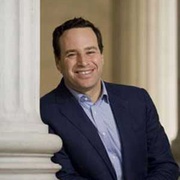
The presidential seal is placed on the podium ahead of President Barack Obama's visit to Lackawanna College Friday, Aug. 23, 2013, in Scranton, Pa. Matt Rourke/AP
What the Next President Should Do With the Iran Deal
The next commander in chief will have fewer and worse options, yet still room to tweak and improve the deal.
The next president of the United States will almost certainly be more hawkish on Iran than Barack Obama. Maybe a little more hawkish, if Hillary Clinton; potentially a lot more hawkish, if a Republican. What can that president do aboutthe nuclear accord that the Obama administration and several world powers have struck with Iran?
On Tuesday, Obama told Thomas Friedman of The New York Times that his Iran deal will equip his successor with more and better options on Iran than he inherited. The opposite is true. The next president will have fewer and worse options, because the most effective sanctions against Iran will have been suspended in a way that is very difficult to reimpose.
But fewer and worse options does not mean zero options. There are things the next president can do to improve a bad deal.
The United States has surrendered much of its leverage over Iran, but not all. Under the terms of the deal, many of which are designed to be in place for 10 years or more, Iran must remove two-thirds of its centrifuges, reduce its enriched-uranium stockpile, and downgrade important nuclear facilities like Arak and Fordow. This work must be completed before sanctions relief begins and before frozen funds start to flow back to Iran.
This work will take some time. There will be a moment when Iran has dismantled a multibillion-dollar nuclear investment and faces a multibillion-dollar price tag to rebuild it. Exactly how long that moment will last is difficult to say. As part of the agreement, Iran will retain a considerable nuclear infrastructure and will continue to enrich uranium with its remaining centrifuges. The unfreezing of as much as $100 billion of Iranian assets worldwide will provide Iranian officials with new resources. Still, for some period of months, the prospect of the nuclear deal failing will be very frightening for the country’s rulers. Much of their old nuclear program will be gone, their new program won’t yet have been built, and their cash infusion will only have just begun.
During that period, a new president may be able to press Iran to renegotiate the Obama deal’s worst terms, especially its weak inspection provisions. Presidents have more options than to either accept or junk agreements. They can renegotiate them too, as candidate Barack Obama pledged to renegotiate NAFTAduring the 2008 campaign. He ultimately decided against that course of action, but the option was there. The option will be there with the Iran agreement too.
Iran, after all, faces a long road back to economic normality. The oft-cited reference to Iran’s $100 billion in frozen funds obscures the fact that many of these “funds” take the form of non-cash assets. The Iranian government owns a dozen real-estate properties in the United States. A state-controlled bank owns an interest in a New York office building. Liquidating those assets will take time. They may also prove to have deteriorated in value during the period in which they were frozen.
Sanctions relief may likewise take a while to benefit Iran. The Iranian economy is hobbled by self-imposed restrictions. Multinational oil companies may not rush to invest large sums in a country that continues to hold American hostages—especially not at a time of low and falling oil prices. Iran will surely be better able to afford mischief in five years than today. It’s not so clear that it will have gained much more freedom of maneuver in 18 months.
In other words, the next president will have opportunities to slow, or threaten to slow, Iranian economic recovery as part of an effort to press for renegotiating elements of the current deal. Iran’s rulers have raised expectations of economic betterment inside the country. Those raised expectations may generate useful political pressure on the regime—and useful fears within the regime of the consequences of not delivering on those high hopes.
The next president can also offset some of the negative diplomatic and regional consequences of the deal. Obama accepted the alienation of Israel and the Gulf States as the price of his Iran initiative. The next president can reconstruct those relationships, abandon the illusion of Iranian partnership, and renew the building of a strategic counterweight to Iran. It’s incredible that Iranian rulers got away with offering Iranian cooperation against ISIS as a concession to the United States. ISIS threatens Iran more than it does the United States; it is Iran that needs U.S. help to protect its clients in Syria and Iraq. The next president can wield the real strategic advantage that the United States has over Iran, rather than yield to the imaginary advantage that Iran asserts over the United States.
Admittedly, these aren’t great options. But they are better than zero options, and they are short of war. Obama likewise always had better options than war or this inadequate deal. He did not adequately avail himself of them. The next president could and should.
NEXT STORY: Obama Offers a Forceful Defense of the Iran Deal
